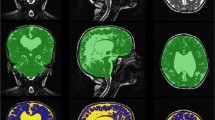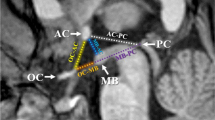Abstract
Background
In the treatment of childhood hydrocephalus, 3D volumetry seems to have many advantages over classical planar index measurements for dedicated monitoring of changes in cerebrospinal fluid and brain volume. Nevertheless, this method requires extensive technical effort and access to the complete three-dimensional data set. Against this background, we evaluated the possibility of planar area determination in a single plane and the correlation to volumetry.
Methods
138 routinely performed true FISP MRI sequences (1 mm isovoxel) were analyzed retrospectively in 68 patients with pediatric hydrocephalus. After preprocessing, the 3D-data sets were skull stripped to estimate the inner skull volume. A 2-class segmentation into different tissue types (brain matter and CSF) was performed, and the volumes of CSF (VCSF) and brain matter (VBrain) were calculated. A plane at the level of the foramina of Monro was manually identified in the ac-pc oriented data. In this plane, the areas of brain (ABrain) and CSF (ACSF) in cm2 were calculated and used for further correlation analysis.
Results
Mean VCSF was 340 ± 145 cm3 and VBrain 1173 ± 254 cm3. In the selected plane, ACSF was 26 ± 14 cm2, and ABrain was 107 ± 25 cm2. There was a very strong positive correlation between both ACSF and VCSF (r = 0.895) and between ABrain and VBrain (r = 0.846). The prediction equations for VBrain and VCSF were highly significant.
Conclusion
Planar area determination of brain and CSF correlates excellently with both VCSF and VBrain. Thus, areas can serve as a surrogate marker for total brain and CSF volumes for a quantitated objective tracking of changes during treatment of childhood hydrocephalus.





Similar content being viewed by others
Abbreviations
- CSF:
-
Cerebrospinal fluid
- VP shunt:
-
Ventriculoperitoneal shunt
- ETV:
-
Endoscopic third ventriculostomie
- MRI:
-
Magnet resonance imaging
- VBrain:
-
Brain volume in cm3
- VCSF:
-
CSF volume in cm3
- ABrain:
-
Planar area of brain in cm2
- ACSF:
-
Planar area of CSF in cm2
- ICV:
-
Intracranial volume in cm3
- FSL:
-
Functional magnetic resonance imaging of the brain software library
- BET:
-
Brain extraction tool
- FAST:
-
FMRIB’s automated segmentation tool
- True FISP:
-
True fast imaging with steady state precession
- SD:
-
Standard deviation
- FOHR:
-
Frontal occipital horn ratio
References
Grimm F, Edl F, Gugel I, Kerscher SR, Bender B, Schuhmann MU (2019) Automatic volumetry of cerebrospinal fluid and brain volume in severe paediatric hydrocephalus, implementation and clinical course after intervention. Acta Neurochir (Wien) accepted. https://doi.org/10.1007/s00701-019-04143-5
Jenkinson M, Beckmann CF, Behrens TE, Woolrich MW, Smith SM (2012) Fsl. NeuroImage 62:782–790. https://doi.org/10.1016/j.neuroimage.2011.09.015
Limbrick DD Jr, Baird LC, Klimo P Jr, Riva-Cambrin J, Flannery AM, Pediatric Hydrocephalus Systematic R, Evidence-Based Guidelines Task F (2014) Pediatric hydrocephalus: systematic literature review and evidence-based guidelines. Part 4: Cerebrospinal fluid shunt or endoscopic third ventriculostomy for the treatment of hydrocephalus in children. J Neurosurg Pediatr 14(Suppl 1):30–34. https://doi.org/10.3171/2014.7.PEDS14324
Mandell JG, Kulkarni AV, Warf BC, Schiff SJ (2015) Volumetric brain analysis in neurosurgery: part 2. Brain and CSF volumes discriminate neurocognitive outcomes in hydrocephalus. J Neurosurg Pediatr 15:125–132. https://doi.org/10.3171/2014.9.PEDS12427
Mandell JG, Langelaan JW, Webb AG, Schiff SJ (2015) Volumetric brain analysis in neurosurgery: part 1. Particle filter segmentation of brain and cerebrospinal fluid growth dynamics from MRI and CT images. J Neurosurg Pediatr 15:113–124. https://doi.org/10.3171/2014.9.PEDS12426
Mendrik AM, Vincken KL, Kuijf HJ, Breeuwer M, Bouvy WH, de Bresser J, Alansary A, de Bruijne M, Carass A, El-Baz A, Jog A, Katyal R, Khan AR, van der Lijn F, Mahmood Q, Mukherjee R, van Opbroek A, Paneri S, Pereira S, Persson M, Rajchl M, Sarikaya D, Smedby O, Silva CA, Vrooman HA, Vyas S, Wang C, Zhao L, Biessels GJ, Viergever MA (2015) MRBrainS challenge: online evaluation framework for brain image segmentation in 3T MRI scans. Comput Intell Neurosci 2015:813696. https://doi.org/10.1155/2015/813696
Moeskops P, Benders MJ, Chit SM, Kersbergen KJ, Groenendaal F, de Vries LS, Viergever MA, Isgum I (2015) Automatic segmentation of MR brain images of preterm infants using supervised classification. Neuroimage 118:628–641. https://doi.org/10.1016/j.neuroimage.2015.06.007
O'Neill BR, Pruthi S, Bains H, Robison R, Weir K, Ojemann J, Ellenbogen R, Avellino A, Browd SR (2013) Rapid sequence magnetic resonance imaging in the assessment of children with hydrocephalus. World Neurosurg 80:e307–e312. https://doi.org/10.1016/j.wneu.2012.10.066
Ragan DK, Cerqua J, Nash T, McKinstry RC, Shimony JS, Jones BV, Mangano FT, Holland SK, Yuan W, Limbrick DD Jr (2015) The accuracy of linear indices of ventricular volume in pediatric hydrocephalus: technical note. J Neurosurg Pediatr 15:547–551. https://doi.org/10.3171/2014.10.PEDS14209
Schmitz B, Hagen T, Reith W (2003) Three-dimensional true FISP for high-resolution imaging of the whole brain. Eur Radiol 13:1577–1582. https://doi.org/10.1007/s00330-003-1846-3
Smith SM (2002) Fast robust automated brain extraction. Hum Brain Mapp 17:143–155. https://doi.org/10.1002/hbm.10062
Toma AK, Holl E, Kitchen ND, Watkins LD (2011) Evans' index revisited: the need for an alternative in normal pressure hydrocephalus. Neurosurgery 68:939–944. https://doi.org/10.1227/NEU.0b013e318208f5e0
Toma AK, Tarnaris A, Grieve JP, Watkins LD, Kitchen ND (2010) Adjustable shunt valve-induced magnetic resonance imaging artifact: a comparative study. J Neurosurg 113:74–78. https://doi.org/10.3171/2009.9.JNS09171
Warf B, Ondoma S, Kulkarni A, Donnelly R, Ampeire M, Akona J, Kabachelor CR, Mulondo R, Nsubuga BK (2009) Neurocognitive outcome and ventricular volume in children with myelomeningocele treated for hydrocephalus in Uganda. J Neurosurg Pediatr 4:564–570. https://doi.org/10.3171/2009.7.PEDS09136
Yepes-Calderon F, Nelson MD, McComb JG (2018) Automatically measuring brain ventricular volume within PACS using artificial intelligence. PLoS One 13:e0193152. https://doi.org/10.1371/journal.pone.0193152
Zhang Y, Brady M, Smith S (2001) Segmentation of brain MR images through a hidden Markov random field model and the expectation-maximization algorithm. IEEE Trans Med Imaging 20:45–57. https://doi.org/10.1109/42.906424
Funding
No funding was received for this research.
Author information
Authors and Affiliations
Corresponding author
Ethics declarations
Conflict of interest
All authors certify that they have no affiliations with or involvement in any organization or entity with any financial interest (such as honoraria; educational grants; participation in speakers’ bureaus; membership, employment, consultancies, stock ownership, or other equity interest; and expert testimony or patent-licensing arrangements), or non-financial interest (such as personal or professional relationships, affiliations, knowledge or beliefs) in the subject matter or materials discussed in this manuscript.
Ethical approval
All procedures performed in studies involving human participants were in accordance with the ethical standards of the institutional and/or national research committee (University Hospital Tübingen, Germany) and with the 1964 Helsinki declaration and its later amendments or comparable ethical standards. For this type of study formal consent was not required.
Additional information
Publisher’s note
Springer Nature remains neutral with regard to jurisdictional claims in published maps and institutional affiliations.
This article is part of the Topical Collection on Pediatric Neurosurgery
Rights and permissions
About this article
Cite this article
Grimm, F., Edl, F., Gugel, I. et al. Planar single plane area determination is a viable substitute for total volumetry of CSF and brain in childhood hydrocephalus. Acta Neurochir 162, 993–1000 (2020). https://doi.org/10.1007/s00701-019-04160-4
Received:
Accepted:
Published:
Issue Date:
DOI: https://doi.org/10.1007/s00701-019-04160-4




